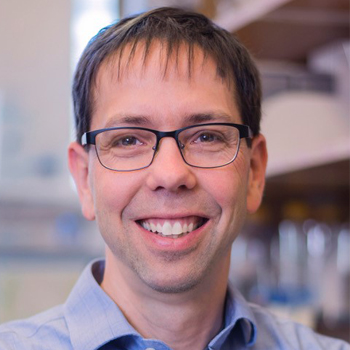Kuhlman solves protein puzzles with a modeling program
The 91—«…´¥´√Ω has given the 2019 DeLano Award for Computational Biosciences to , a professor of biochemistry and biophysics at the University of North Carolina School of Medicine. The award recognizes scientists whose work excels in two key elements: “more productive use of computers to accelerate and facilitate research, and ready access of these programs for the scientific community.”

“What a fantastic honor! Warren DeLano’s software, PyMOL, is a terrific example of what can be achieved by making research tools easily accessible. It has been very rewarding to contribute to the Rosetta software and community in the same way, and it is exciting to see all of the wonderful proteins that are being designed with Rosetta.”
— BRIAN KUHLMAN
Kuhlman’s studies have done exactly that; of the National Cancer Institute wrote in her nomination letter, “I cannot think of a more deserving recipient than Prof. Kuhlman.”
Kuhlman’s work can be described broadly as using computers and computational biology to design new protein structures and functions. As a postdoc in David Baker’s laboratory, Kuhlman created a protein design module in the molecular modeling software Rosetta. As a professor, he has continued to advance the uses of Rosetta in several forms: protein interface design, antibody assembly and engineering photoactivatable proteins. He makes the modules available to all researchers.
In the field of protein interface design, Kuhlman’s lab has redesigned proteins to increase their affinity to binding partners and has designed interfaces that allow previously nonbinding proteins to bind each other or other substrates they would not typically bind. This has achieved binding with micro to nanomolar affinities, and the experimentally determined structures of his designed interfaces typically were quite similar to his models, showing how effective his modeling techniques are. This work and his freely available Rosetta modules open the doors for many researchers to use these ideas in countless other fields.
of the Weizmann Institute of Science wrote in support of the nomination that Kuhlman “is known for driving technology as well as using it in biologically important applications.”
Kuhlman’s group has worked to solve the longstanding problem of creating bispecific antibodies, antibodies that bind two different antigens, by creating a novel protocol for multi-state protein design. They generated two different light and heavy chains with orthogonal interfaces that can be assembled with high fidelity. This has significant potential in any field where two cellular structures need to be brought in close proximity, including cancer immunotherapy.
The lab is also working on creating protein switches that can be turned on or off using light with high spatial and temporal resolution. They are designing these switches to control intracellular localization, gene expression and differentiation.
Kuhlman is known among his colleagues as an innovative and reliable scientist, an effective and wise collaborator, and a superb speaker. This is shown in his high (and increasing) number of citations, his many papers written in collaboration with other labs and the many talks he gives around the world.
Kuhlman will receive his award during the 91—«…´¥´√Ω annual meeting at the Experimental Biology 2019 conference in Orlando, where he will deliver an award lecture titled “Designing novel protein structures and interactions with Rosetta” at 1:45 p.m. April 9 in Valencia Ballroom A at the Orange County Convention Center.
Enjoy reading 91—«…´¥´√Ω Today?
Become a member to receive the print edition four times a year and the digital edition monthly.
Learn moreGet the latest from 91—«…´¥´√Ω Today
Enter your email address, and we’ll send you a weekly email with recent articles, interviews and more.
Latest in People
People highlights or most popular articles

How HCMV hijacks host cells — and beyond
Ileana Cristea, an 91—«…´¥´√Ω Breakthroughs webinar speaker, presented her research on how viruses reprogram cell structure and metabolism to enhance infection and how these mechanisms might link viral infections to cancer and other diseases.

Understanding the lipid link to gene expression in the nucleus
Ray Blind, an 91—«…´¥´√Ω Breakthroughs speaker, presented his research on how lipids and sugars in the cell nucleus are involved in signaling and gene expression and how these pathways could be targeted to identify therapeutics for diseases like cancer.

In memoriam: William S. Sly
He served on the 91—«…´¥´√Ω Council in 2005 and 2006 and was an 91—«…´¥´√Ω member for 35 years.

91—«…´¥´√Ω committees welcome new members
Members joined these committees: Education and Professional Development, Maximizing Access, Meetings, 91—«…´¥´√Ω, Public Affairs Advisory, Science Outreach and Communication, Student Chapters and Women in Biochemistry and Molecular Biology.

Cadichon honored for academic achievement
She won the State University of New York at Old Westbury’s Dr. Henry Teoh Award for Outstanding Collegiate Science and Technology Entry Program Graduating Senior, which recognizes exceptional achievement, leadership and promise in a student.

In memoriam: Ralph G. Yount
He was a professor emeritus of chemistry and biochemistry at Washington State University and an 91—«…´¥´√Ω member for 58 years.

